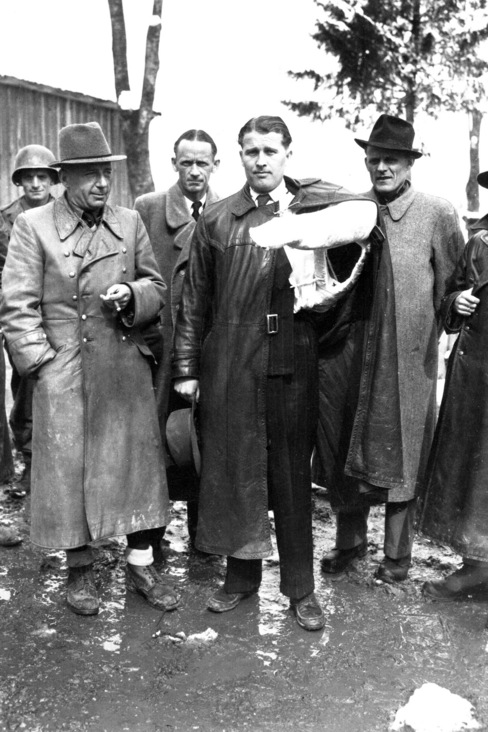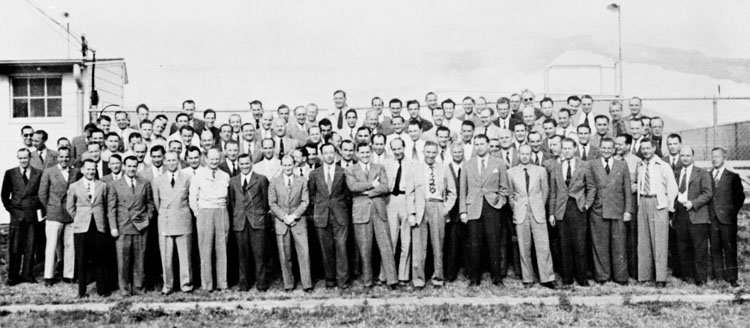Origins of Paperclip:
- In May 1945, after the fall of the Nazi regime, Russian soldiers secured the German atomic research laboratories at the
prestigious Kaiser Wilhelm Institute in the suburbs of Berlin, giving Stalin the foundations of what would become a vast Soviet
nuclear arsenal. Meanwhile, US forces removed V-2 missiles from the labyrinthine Nordhausen complex, built under the Harz Mountains
in central Germany, just before the Soviets took over the factory, in what would become their area of occupation. And the team which
had built the V-2, led by von Braun, also fell into American hands.
- Shortly afterward Major-General Hugh Knerr, deputy commander of the US Air Force in Europe, wrote: "Occupation of German scientific
and industrial establishments has revealed the fact that we have been alarmingly backward in many fields of research. If we do not
take the opportunity to seize the apparatus and the brains that developed it and put the combination back to work promptly, we will
remain several years behind while we attempt to cover a field already exploited."
- Thus began Operation Paperclip, the exercise that saw von Braun and more than 700 others spirited out of Germany from under the
noses of the United State′s allies. Its aim was simple: "To exploit German scientists for American research and to deny these
intellectual resources to the Soviet Union."
Hidden truths:
- President Truman authorized Paperclip in August 1945 and, on November 18, the first Germans reached America.
President Harry Truman had given the go-ahead to Paperclip on condition that none
of the detainees could be shown to have been members of the Nazi party or active
supporters of the Hitler regime. However, it is now clear that many of the key
figures in the roundup, including von Braun himself, Arthur Rudolph,
and Hubertus Strughold, had been enthusiastic
Nazis and, in some cases, had been aware of, or even involved in, atrocities inflicted
on concentration camp detainees. All of these men were cleared to work for the US, their alleged crimes covered up and their backgrounds
glossed over by a military which saw winning the Cold War as its all-consuming priority.
Arrival in the United States:
- The first Paperclip group of seven scientists, headed by von Braun, arrived at Boston′s Fort Strong on Sep. 29, 1945.
Before this group departed from Germany, von Braun spent two weeks in Britain, where he was questioned by Sir Alwyn Crow and other
Ministry of Supply officials. After processing, six of the seven scientists went to Aberdeen Proving Ground, where they began sorting
out the tons of documents that had been shipped from the Dörten Mine in Germany. Von Braun, who was met by Major James P. Hamill in
Boston, stopped in Washington to meet with several high-ranking Army Ordnance officers, while the other members of the vanguard
group – Erich W. Neubert, Theodor A. Poppel, August Schultze, Eberhard Rees, Wilhelm Jungert, and Walter Schwidetsky – went directly
to Aberdeen.
- Hamill began arranging to transfer the scientists to Fort Bliss, Texas, a large Army installation just north of El Paso, Texas,
where they were to start establishing a United States guided-missile program. The main body of Germans began arriving at Fort Bliss
in December 1945, and by February 1946 over a hundred were on hand. They were quartered in converted buildings that gradually became
more homelike.
- The test facilities became more elaborate as the program picked up speed. The first static firing test of a V-2 power plant in
the United States took place on Mar. 14, 1946, and soon afterward a series of test flights began. The first American-adapted V-2 was
flown from the White Sands Proving Ground, New Mexico, on Apr. 16, 1946.
- 28 Octobre 1949: Von Braun team moved to Huntsville. The Secretary of the Army approved the transfer of the Ordnance
Research and Development Division, Sub-Office (Rocket) at Fort Bliss, Texas, to Redstone Arsenal. Among those transferred were Dr.
Wernher von Braun and his team of German scientists.
|

